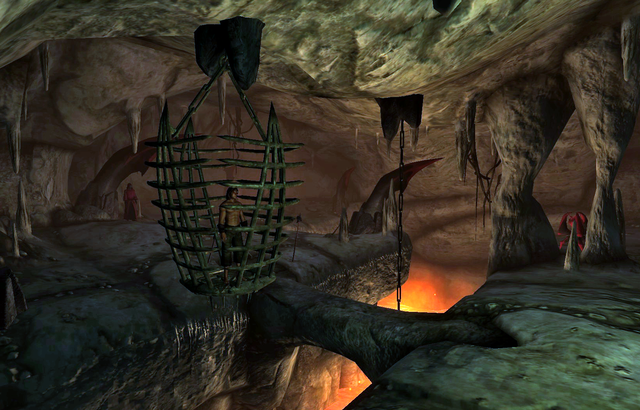

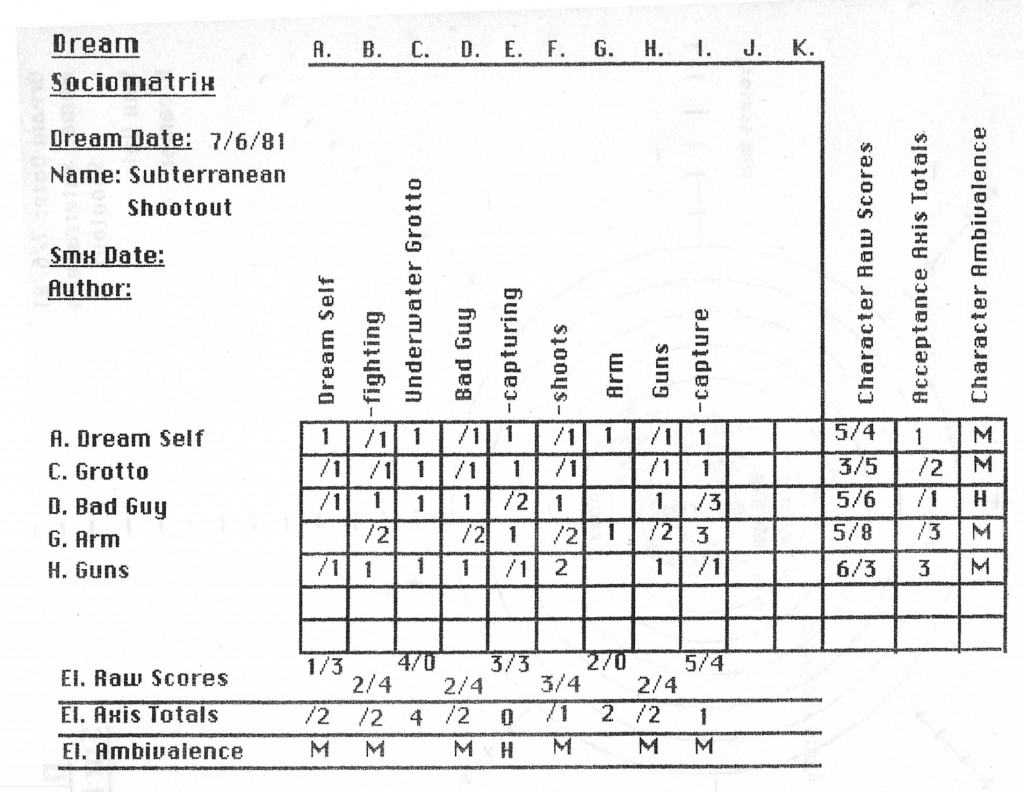

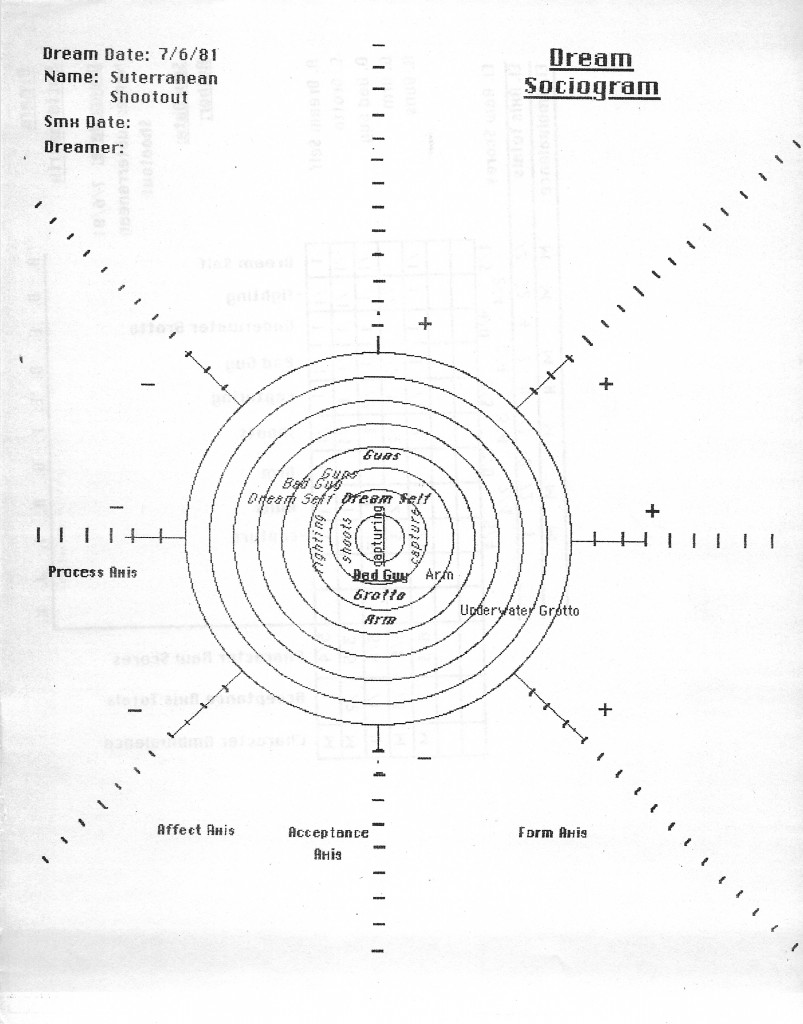
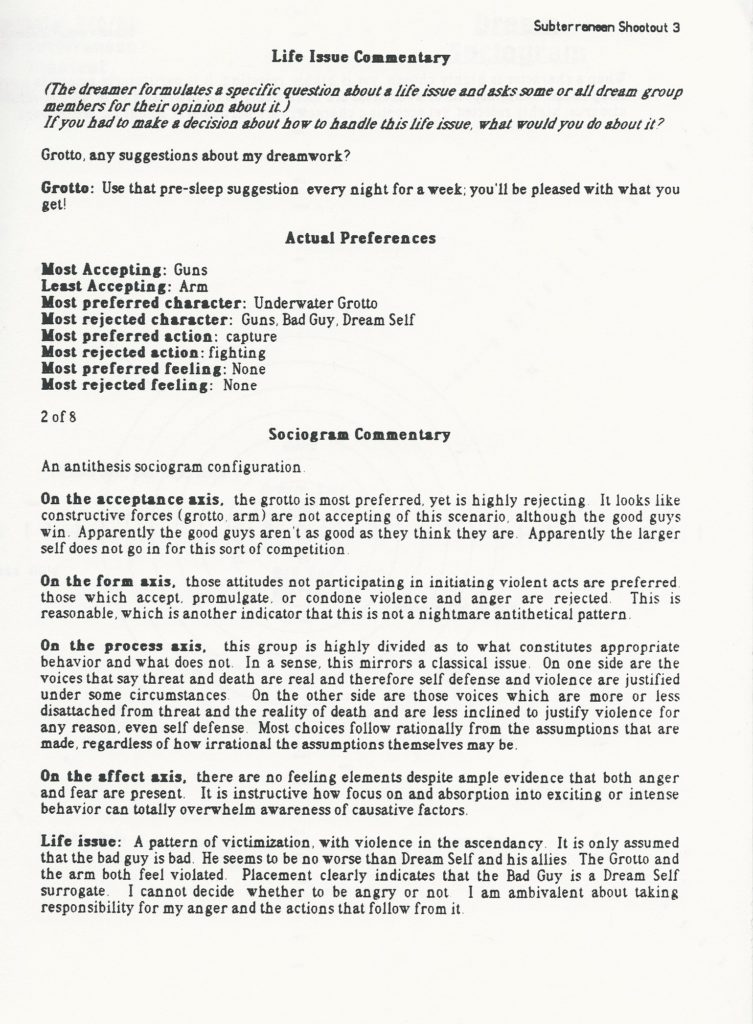
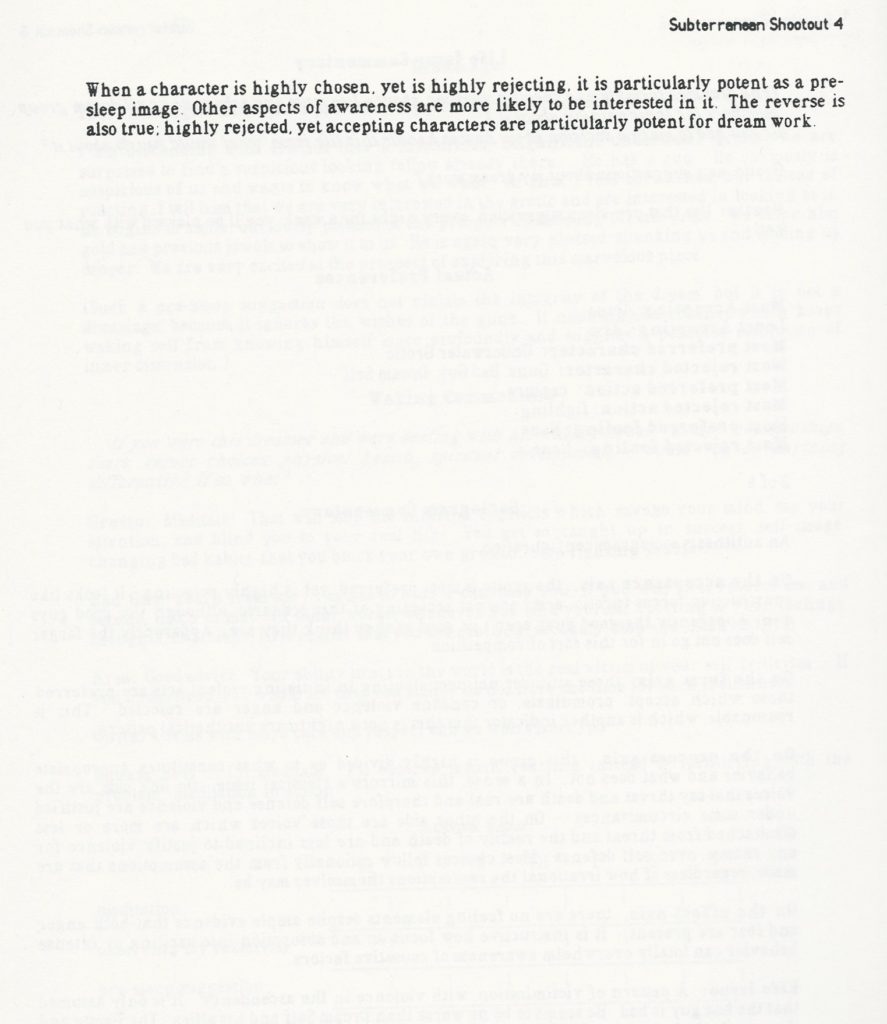
This is a good example of how the Drama Triangle expresses itself in dreams due to a lack of lucidity on the part of the dreamer. By “lucidity” I am not referring to lucid dreaming; you don’t have to know you are dreaming to be lucid or clear in a dream. In this case, all that would be necessary would be to recognize that this is self-destructive drama and do something else – not participate or interview a character. Unfortunately, the best most of us can muster is to change to dreaming something else or to wake ourselves up, neither of which develop life-changing lucidity or clarity.
In the SMX, the most obvious thing that jumps out is the relatively non-intense strength of preferences in a dream of fighting and violence. There is only one instance of love and one of hate. The second thing is that there is still an amazing amount of conflict as you can see from the raw scores and the character ambivalence being either medium (40-70%) or high (70-99%).
In the SGM we see that while the group prefers the Grotto and Arm (on the Process Axis), both are rejecting (on the Acceptance Axis). This implies a nightmare antithesis pattern, in which preferred choosers are rejecting and elements they reject – in this case Guns, are most preferring. Bad Guys is not preferring only because he gets captured.
It would probably be accurate to say that most all characters experience themselves in the role of victim in this dream. Dream Self, because he is caught up in violent conflict, the Robber because he is caught, Arm because it is shot, and Grotto because it is abused with violence. There is little ownership of persecution/self-persecution or how the self-rescuing of capturing the Bad Guy does nothing to resolve the life issues that generate violence in the first place.
The underlying conflicts are most likely both emotional – self-doubt and disapproval of self – and cognitive – worry and self-criticism. No recommendations were sought at that time so we only have the opportunity to witness a fairly typical way one gets stuck and stays stuck in common life issues, without getting direction of what to do about them.
Below are original remarks I made around the time I created the SMX and SGM.
Examples of Sociometric Dream Interpretation In “Subterranean Shootout,” 7/ 6/81, we have a “cops and robbers” dream. What follows is an example of the thought processes I might use in working with a dream after I have written down the dream, noted any associations and meanings, completed the sociomatrix, commenatries, and sociogram. I ask myself a number of questions: What emotional patterns are expressed in this dream? What is the theme of this dream? I re-read the dream and formulate a tentative theory: The dream deals with some sort of violence and conflict in my life. Probably something self-destructive that I am doing, thinking, or feeling is being addressed. Next, I look on the dream note card to see if I wrote down any associations to life issues on the back of the card. Nope. I look at the sociomatrix. How strong are my preferences? They are fairly weak. There are few circles or minuses. So I know that the life situation is probably not emotionally loaded. That may explain my having no waking associations to the dream. But this does not fit, considering the violent content of the dream and the fact that I am a participant, not an observer in the dream. It seems that more intense preferences would be expressed. I am not emotionally involved, even though Dream Self is fighting in the dream and could be “physically” injured. Odd. So my lack of feeling in the life situation, whatever it is, is probably inappropriate. Because my preferences are not strong I know that my Dream Sociogram placements will be toward the center, with conflict not expressed as strongly as might be expected.
What does my sociomatrix commentary tell me? I like feeling secure and remote in this particular life situation. (Perhaps I am hiding my violence and turmoil from myself and others.) A natural part of myself, the grotto, doesn’t like the disruption. It doesn’t like containing such violence. (Could this be my body speaking? I can go back and ask it and find out.) If this is true, then I need to ask myself, “What life stresses am I internalizing? What am I somatizing? Anger?” In waking life I don’t like guns. And so it is no surprise that the guns in the dream are disapproving and critical toward Dream Self. Of course, the dream points up an inconsistency: Dream Self is using guns when in waking life I would not think of it. This sounds hypocritical and deceptive. So, I must ask myself, “In what way am I hypocritical when dealing with conflict?” Apparently, not wanting to give myself an answer to such a probing question, I go on to the Dream Sociogram. I find that there is opposition on both the action and character axes and that there is no affect, despite the fact that I generally have emotional elements in my dreams and this dream deals with a very emotional issue: survival. There is also a very strong opposition on the acceptance axis, particularly given the weak preferences stated. Perhaps this is created by the avoidance of feeling: what is set up internally as a result is a great deal of non-acceptance of self. The ambivalence may also be a result of non-awareness. The energy associated with the conflict/ambivalence is not clearly directional and is turned in on itself, creating confusion and a kind of psychic constipation. All rejected characters are ambivalent. All actions are ambivalent. All characters on the acceptance axis are as well, with high internal ambivalence in all but one. I am clearly in a lot of inner turmoil regarding what to think and how to act in this life situation. I won’t even let myself feel in it, I am in such turmoil. In turn, the lack of awareness and feeling probably create patterns of opposition. I don’t like what I’m thinking and what I’m doing in and I won’t let myself look at my feelings. What alignments of dream group members (clusters) are evident? Dream Self and his antagonist, the “bad guy” are surrogates, aligned on the form axis. In what ways am I creating this unpleasant conflict in my life by acting/thinking/feeling like this robber does? When am I sneaky and dishonest? Ah! I can think of several situations. I seem as if I am more sexually together than I am. I loaf on my job some, because I don’t like it very much, and I try to hide it. (At the time I was administering a youth home.) But these things do not hit at the antagonistic, angry part of the pattern.
Embarrassingly, my Dream Self ends up accepting conflict and self-destruction. The pattern is one of choosing failure, although with great ambivalence. The thing feels like self-criticism: how I feel when I criticize myself or someone else (angry). (Of course, in the logic of the dream world, criticism of someone else is always experienced as self-criticism.) Perhaps the dream is saying that when I indulge in criticism I think I am doing so privately. The price I pay is damage to my body, and emotional blocking. I become cool, distant, secretive. I isolate myself from important parts of myself and make myself no bettr than that which I criticize. Indeed, I draw myself to that I criticize and marry myself to it in the eyes of my larger self (the dream group.) (This is the same pattern we see when one nation returns violence with violence. Both sides lose their distinctiveness to the eyes of an univolved third party. Seen impartially, they are both aggressors.) The implication is that if I can get in touch with my likes and dislikes and express them, I can deal with them instead of blocking off my true attitudes and preferences. This is what Dream Sociometry teaches us to do. This by no means exhausts the insights available from this one particular sociogram, but it serves to give an example of how this process can get the cerebral juices flowing on some very important questions on which one previously lacked a handle.
All that was written 1981.
Examples of Sociometric Dream Interpretation
In “Subterranean Shootout,” 7/ 6/81, we have a “cops and robbers” dream. What follows is an example of the thought processes I might use in working with a dream after I have written down the dream, noted any associations and meanings, completed the sociomatrix, commenatries, and sociogram. I ask myself a number of questions:
What emotional patterns are expressed in this dream?
What is the theme of this dream?
I re-read the dream and formulate a tentative theory: The dream deals with some sort of violence and conflict in my life. Probably something self-destructive that I am doing, thinking, or feeling is being addressed.
Next, I look on the dream note card to see if I wrote down any associations to life issues on the back of the card. Nope.
I look at the sociomatrix. How strong are my preferences?
They are fairly weak. There are few circles or minuses. So I know that the life situation is probably not emotionally loaded. That may explain my having no waking associations to the dream. But this does not fit, considering the violent content of the dream and the fact that I am a participant, not an observer in the dream. It seems that more intense preferences would be expressed. I am not emotionally involved, even though dream self is fighting in the dream and could be “physically” injured. Odd. So my lack of feeling in the life situation, whatever it is, is probably inappropriate.
Because my preferences are not strong I know that my sociogram will not be exploded. Instead, it will be contained toward the center, with life forces not expressed as strongly as might be expected.
What does my sociomatrix commentary tell me?
I like feeling secure and remote in this particular life situation. (Perhaps I am hiding my violence and turmoil from myself and others.) A natural part of myself, the grotto, doesn’t like the disruption. It doesn’t like containing such violence. (Could this be my body speaking? I can go back and ask it and find out.) If this is true, then I need to ask myself, “What life stresses am I internalizing? What am I somatizing? Anger?”
In waking life I don’t like guns. And so it is no surprise that the guns in the dream are disapproving and critical toward Dream Self. Of course, the dream points up an inconsistency: Dream Self is using guns when in waking life I would not think of it. This sounds hypocritical and deceptive. So, I must ask myself, “In what way am I hypocritical when dealing with conflict?” Apparently, not wanting to give myself an answer to such a probing question, I go on to the sociogram.
I find that there is opposition on both the action and character axes and that there is no affect, despite the fact that I generally have emotional elements in my dreams and this dream deals with a very emotional issue: survival.
There is also a very strong opposition on the acceptance axis, particularly given the weak preferences stated. Perhaps this is created by the avoidance of feeling: what is set up internally as a result is a great deal of non-acceptance of self.
The ambivalence may also be a result of non-awareness. The energy is not clearly vectored and is turned in on itself, creating confusion and a kind of psychic constipation. All rejected characters are ambivalent. All actions are ambivalent. All characters on the acceptance axis are as well, with high internal ambivalence in all but one. I am clearly in a lot of inner turmoil
regarding what to think and how to act in this lafe situation. I won’t even let myself feel in it, I am in such turmoil. In turn the lack of awareness and feeling probably create patterns of opposition: urobos. I don’t like what I’m thinking and what I’m doing in and I won’t let myself look at my feelings.
What alignments of dream group members (clusters) are evident?
Dream Self and his antagonist, the “bad guy” are surrogates, aligned on the form axis. In what ways am I creating this unpleasant conflict in my life by acting/thinking/feeling like this robber does? When am I sneaky and dishonest? Ah! I can think of several situations. I seem as if I am more sexually together than I am. I loaf on my job some, because I don’t like it very much, and I try to hide it. (At the time I was administering a youth home.) But these things do not hit at the antagonistic, angry part of the pattern.
Embarassingly, my Dream Self ends up accepting conflict and self-destruction. The pattern is one of choosing failure, although with great ambivalence. The thing feels like self-criticism: how I feel when I criticize myself or someone else (angry). (Of course, in the logic of the dream world, criticism of someone else is always experienced as self-criticism.) Perhaps the dream is saying that when I indulge in criticism I think I am doing so privately. The price I pay is damage to my body, and emotional blocking. I become cool, distant, secretive. I isolate myself from important parts of myself and make myself no bettr than that which I criticize. Indeed, I draw myself to that I criticize and marry myself to it in the eyes of my larger self (the dream group.) (This is the same pattern we see when one nation returns violence with violence. Both sides lose their distinctiveness to the eyes of an univolved third party. Seen impartially, they are both aggressors.)
The implication is that if I can get in touch with my likes and dislikes and express them, I can deal with them instead of blocking off my true attitudes and preferences. This is what Dream Sociometr teaches us to do.
There are many other insights and applications that follow when this or any other dream is used to construct a dreamage and a waking action plan. This by no means exhausts the insights available from this one particular sociogram, but it serves to give an example of how this process can get the cerebral juices flowing on some very important questions on which one previously lacked a handle.
